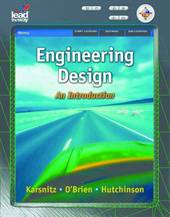
|
Engineering Design: An Introduction
Hardback
Main Details
Description
With an innovative approach that uses projects and student exploration as key learning tools, Engineering Design: An Introduction offers an overview of the basic engineering principles and concepts that shape today's modern world. These concepts are presented in a flexible, two-part format. Part I describes the process of engineering and technology product design, while Part II develops specific skill sets needed to understand and participate in the process. Opportunities to experiment and learn abound, with projects ranging from technical drawing to designing electrical systems and more. With this emphasis on project-based learning, the book is an ideal supplement to Project Lead the Way's innovative series of project-based curricula designed to increase student interest in engineering careers. Engineering Design's broad scope and sound coverage of the essential concepts and techniques used in engineering design making it the perfect addition to any curriculum.
Author Biography
John Hutchinson is an emeritus professor in the Department of Technological Studies at The College of New Jersey. He holds a Ph.D. from the Pennsylvania State University and has authored books on Design and Problem Solving in Technology and Designing with Pro/DESKTOP. Dr. Hutchinson taught at the high school, community college, and college level for more than 35 years. During his tenure, Dr. Hutchinson worked closely with colleagues from the United States, United Kingdom, Germany, and other countries in design and technology curriculum development. John R. Karsnitz, Ph.D., is professor and chair of the Department of Technological Studies in the College of New Jersey's School of Engineering, where he coordinates the Professional Studies and Technological Design strand. His teaching emphasizes multimedia, architectural, and civil engineering design, as well as technology education, while his primary research interests include technological literacy in general education, pre-engineering, and STEM education. In addition to authoring several textbooks and presenting at many state and regional conferences, Dr. Karsnitz is an active member of several professional organizations. His current affiliations include the International Technology Education Association (ITEA), the Council on Technology Teacher Education (CTTE), the New Jersey Technology Education Association (NJTEA), and the New Jersey Engineering Education Council (NJEEC). Dr. Karsnitz earned B.S. and M.Ed. degrees from Millersville University and a Ph.D. from The Ohio State University. Following a successful career in electrical engineering, in 2006 Stephen O'Brien, Ph.D., joined the faculty of The College of New Jersey, where he is an associate professor of technological studies in the School of Engineering. He also coordinates the Electrical Engineering Design strand and is director of the college's Center for Excellence in STEM Education. His teaching focuses on engineering math, analog circuits, digital electronics, robotics and controls, and advanced engineering design. Dr. O'Brien's scholarly work includes over 40 publications and 13 patents, primarily in the field of optoelectronic devices, as well as frequent presentations at national professional conferences. His research interests include the efficacy of STEM training and education, as well as interdisciplinary work combining humanities, engineering, and technology. He earned a B.S. in math and physics from Western Washington University and an M.S. and Ph.D. in electrical engineering from Cornell University.
ReviewsPART ONE Chapter 1 Technology: The Human-Designed World Chapter 2 The Process of Design Chapter 3 Development of the Team Chapter 4 Drawing and Documenting Chapter 5 Reverse Engineering Chapter 6 Investigation and Research for Design Development Chapter 7 Generating and Developing Ideas Chapter 8 Testing and Evaluating Chapter 9 Manufacturing PART TWO Chapter 10 Technical Drawing Chapter 11 Designing Structural Systems Chapter 12 Designing Mechanical Systems Chapter 13 Designing Electrical Systems Chapter 14 Designing Pneumatic Systems Chapter 15 Human Factors in Design and Engineering Chapter 16 Math and Science Applications Chapter 17 Graphics and Presentation Appendix: The Nominal Group Technique Glossary of Terms
|